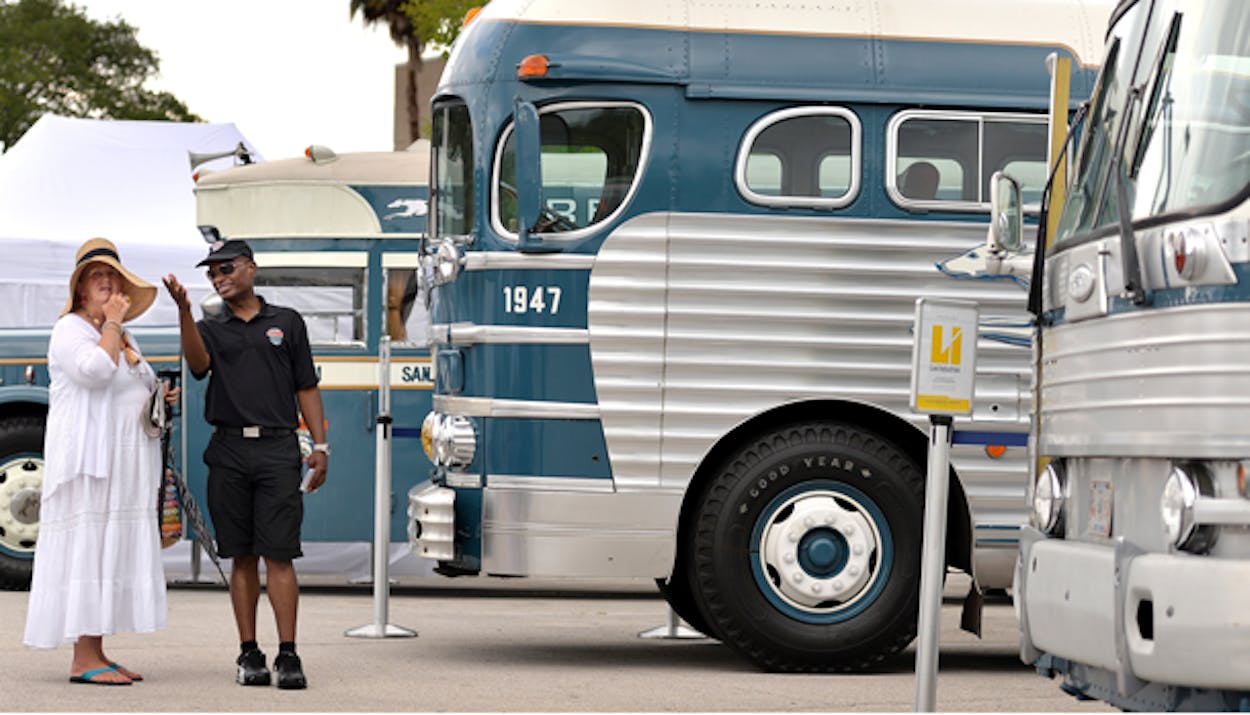Megabus and other budget bus lines have crowded the highway in the last decade, but the nation’s oldest and biggest service is still Greyhound, now celebrating one hundred years of operation.
Greyhound’s fleet of 1,200 buses in the United States and Canada carries eighteen million customers each year some 5.5 billion miles each year (that’s thirty round trips to the sun). The competition, with $1 fares and perks like guaranteed seats and Wi-Fi, does not worry Greyhound’s president and chief executive David Leach, 49. “What gives me a lot of confidence about the future is that there are competitors showing up,” Leach said in his light-filled corner office at One Dallas Centre. “They add more people to the market, and when we have growth in the market, our products are really competitive.” More competitors mean more consumers who may acquire a taste for riding the bus. (Leach started at Greyhound Canada in 1986, working as a baggage handler while in college in Edmonton. He worked his way up to head of Canadian operations before becoming the chief operating officer of United States, Canadian, and Mexican operations.)
Greyhound traces its roots to May 9, 1914, when a Swedish immigrant named Carl Eric Wickman began charging miners fifteen cents to ride from their homes in Hibbing, Minnesota, to an iron ore mine in nearby Alice. The Mesaba Transportation Company quickly expanded to serve the general public and had eighteen buses by 1918.
The company began using the slogan “the greyhounds of the highway” in the twenties, a reference to its gray buses, and in 1929, the company changed its name to the Greyhound Corporation in 1929, putting the sleek, sprinting dog in its logo. Greyhound spent much of the next half-century gobbling up smaller bus lines, and bought its biggest competitor, Trailways, in 1987. That’s the same year it shifted its headquarters to Dallas from Phoenix.
Greyhound is marking its centennial with a traveling exhibition, sending eight old vehicles—including the first, a seven-seat 1914 Hupmobile, and a 1947 Silversides coach—to 39 cities. They will be in Dallas for the State Fair from September 26 to October 19.
A century after the company’s start, the bus remains a particularly affordable alternative for those who make plans late. Riders tend to buy tickets at the last minute, according to an April study from DePaul University’s Chaddick Institute for Metropolitan Development, and a one-way Greyhound ticket from Houston to Dallas bought a day before runs about $21, about ten percent of a plane ticket for the same trip. While a Greyhound bus trip might be cheaper than flying or taking the train, Leach said, “our biggest competitor, by far, is the automobile.” But as highways grow more congested, the lure of bus travel is growing, he said.
Leach also likes having Greyhound stations close to other transit companies. “If you look at any world-class city, they have hubs of transportation,” he said. “You should be able to ride DART and then get on a Greyhound bus.” Greyhound is taking steps, like building new terminals close to train stations, to make switching easier, he said.
Discount bus lines are the fastest-growing sector of the market, according to the DePaul study. After the start of Megabus in 2006, Greyhound established BoltBus two years later, outfitting its buses with leather seats, Wi-Fi, and electrical outlets. Unlike traditional Greyhound service, BoltBus offers guaranteed seats, and boarding at curbside rather than at a terminal. “We treated BoltBus as a laboratory of what consumers would want,” Leach said.
The company has applied the lessons learned from BoltBus, revamping its fleet to offer the same amenities and starting Greyhound Express in 2010 for trips with no more than one stop. The upgrades appear to have paid off: in the fiscal year 2014, Greyhound reported a profit of $73.2 million, up from $39.6 million in 2010, though down from $87.5 million in 2013.
Mike Pentecost, who chronicled the thirty days he spent riding Greyhound in his 2012 book Bus People, said that while Greyhound could be inconvenient and unglamorous, with ten-hour journeys sometimes marked by long delays, he was struck by the sense of community people forged on long trips. “People deep down are aching to connect,” he said. “And for those, four, five, ten hours on the bus, just traveling in that metal tube affords people an opportunity to belong that you just can’t replicate on an airplane.”
Connecting with passengers is one of Tom Shaffer’s favorite parts of driving for Greyhound, a job he has had since 1987. He makes a point of striking up conversations with his passengers, something that paid off in 1992 while he was driving from Dallas to Jackson, Mississippi. A woman he was speaking to turned out to be from his hometown and knew his biological brother, whom he had been trying to find for 29 years.
“If it wasn’t for me getting this job at Greyhound, I don’t think to this day I’d be reconnected with my biological family,” Shaffer said. “We were reunited through a chance meeting. You just never know who you’ll cross paths with on the bus.”







